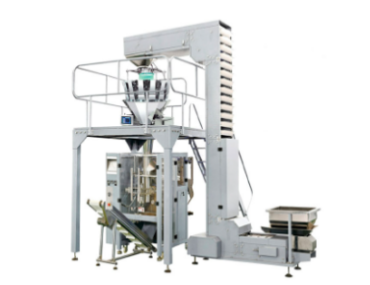To be a distributor
Ask a question
Make an enquiry
Vertical form fill and seal (VFFS) machines are conventional bagging machines used to pack goods into bags as part of a production line. These packaging machines can be configured in various ways and come in different sizes with different functions. A typical example of a VFFS bag is the crisp bag, but they can also be used for liquid or dry products and are used in a variety of settings.
As the name suggests, the machine first forms a packaging bag. The product is then placed inside the bag, sealed, and shipped. Since the bag is made from the product to be packaged, the process is very fast and the unit cost can be significantly reduced compared to using ready-made bags.
The first thing the machine does is form the bag from a roll of film. The width of the bag is determined by the design of the forming tube and the length is ultimately controlled by the packaging machine. If the width of the bag needs to be changed, the operator immediately changes the forming tube. The packaging machine runs the film through the forming tube, forms it to the correct bag size, and seals the bottom and vertical seam where the two edges of the film meet.
The forming tube’s design sets the width of the bag, with the length ultimately controlled by the bagging machine itself. To switch over to a different bag width, an operator can quickly swap in a new forming tube.
There are a few different types of seals, but the two basic types used are a lap seal and a fin seal. In a lap seal, the two edges of the film overlap and are sealed together, with the back of the top side sealing to the front of the bottom side.
In a fin seal, the forming tube brings the edges of the film together so that it seals the inside surfaces together.
By its design, a lap seal uses less film – the equivalent of the width of the seal – on every bag. However, some films have special barrier layers, such as odor, heat, etc., which don’t allow for the bag to seal properly unless a fin seal is used.
Films may also come with various features, such as zippers or gas release valves to keep products fresh.
There are several types of seals, the main ones being the "lap seal" and the "thin seal". In a lap seal, the two edges of the film are sealed in an overlapping fashion, the back of the top seal and the front of the bottom seal.
In the thin seal, the forming tube joins the edges of the film to seal the inside surface.
In overlap sealing, a small piece of film, corresponding to the width of the seal, is used for each bag. However, some films have a special barrier layer for odor and heat.
Films can also have various features to keep products fresh, such as zippers and gas release valves.
The next process is filling. For this, the bagger is connected to a filling machine, such as a multi-head weigher or a screw or volumetric filling machine.
These two machines are electronically synchronized and the product is automatically poured into the bag when it is ready.
Once the product is in the bag, the top part is then sealed and the bag is finished and cut.
The top seal of the first bag becomes the bottom seal of the next bag and the process is repeated.
Depending on the application, the machine can also be perforated/sealed with a date/batch code, holes for easy opening, or for hanging on the wall.
The bags are then bundled and organized into boxes for shipment to the store or end-user.
We are also a vertical form fill and seal machine supplier, so please contact us if you need one.

Headquarter:
Manufacturing plant:

Become a Distributor
Learn how to become a representative of HiTec in your region / country

Ask a Question

Ask a Question

Get a price/Quote

DOWNLOAD FORM
